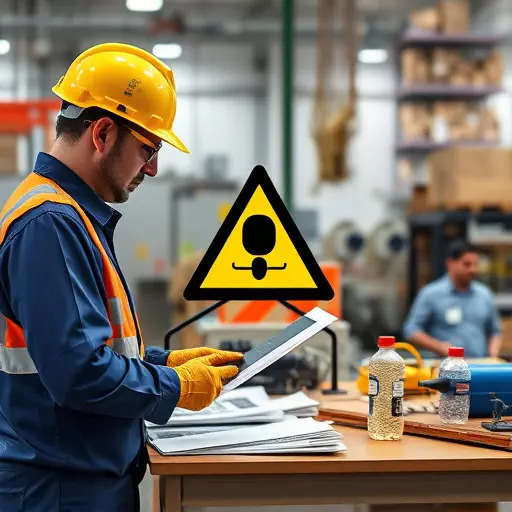Silica Dust Hazards and the Role of Industrial Hygiene Consultants:
Silica dust from materials like cutting or drilling substances containing silica poses significant health risks to workers through inhalation. This microscopic, angular substance can lead to conditions such as silicosis, a chronic lung disease. Industrial hygiene consultants play a vital role in managing these hazards by conducting comprehensive workplace hazard evaluations, identifying risks, and setting occupational exposure limits. They implement controls like respirators, local exhaust ventilation, and engineering solutions to reduce dust generation. Regular monitoring and compliance with established limits are crucial for worker safety against silica dust exposure, preventing long-term health issues.
Silica dust, a ubiquitous yet hazardous substance in various industries, poses significant health risks due to its unique properties. This article explores comprehensive silica hazard management, from understanding its dangers to implementing effective control measures. We delve into the crucial roles of industrial hygiene consultants, offering insights on workplace hazard evaluation and setting occupational exposure limits. Additionally, we provide a step-by-step guide to control measures, emphasizing personal protective equipment (PPE) and monitoring for continuous risk mitigation, ensuring worker safety in silica-prone environments.
- Understanding Silica Dust: Properties and Health Risks
- Role of Industrial Hygiene Consultants in Silica Hazard Management
- Methods for Workplace Hazard Evaluation: A Step-by-Step Guide
- Setting Safe Exposure Limits: Regulatory Frameworks and Standards
- Control Measures to Minimize Silica Dust Exposure
- Personal Protective Equipment (PPE): Protecting Workers from Silica
- Monitoring and Compliance: Ensuring Continuous Risk Mitigation
Understanding Silica Dust: Properties and Health Risks

Silica dust, composed of tiny particles derived from various sources like cutting, grinding, or drilling materials containing silica, poses significant risks to workers’ health when inhaled. These microscopic particles can penetrate deep into the lungs, causing a range of respiratory issues, including silicosis, a chronic lung disease marked by inflammation and scarring. The risk increases with prolonged exposure and higher concentrations of dust in the air.
Industrial hygiene consultants emphasize that understanding silica dust’s unique properties is crucial for effective hazard management. Unlike other particles, silica has a sharp, angular structure that makes it more prone to causing traumatic injuries to lung tissue over time. Occupational exposure limits, such as those set by regulatory bodies, serve as guidelines to protect workers. Regular workplace hazard evaluations and implementing controls like using respirators, wet cutting techniques, or local exhaust ventilation are essential steps to mitigate risks associated with silica dust exposure.
Role of Industrial Hygiene Consultants in Silica Hazard Management

Industrial Hygiene Consultants play a pivotal role in Silica Hazard Management by conducting thorough workplace hazard evaluations. These experts are trained to identify, assess, and mitigate risks associated with inhaling silica dust, which can lead to serious health issues like silicosis and lung cancer. They work closely with employers to understand the specific risks present in various industrial settings where silica is handled or generated, such as construction sites, glass manufacturing plants, and stone cutting facilities.
Through comprehensive evaluations, industrial hygiene consultants determine occupational exposure limits for silica dust, ensuring compliance with regulatory standards. They implement strategies to control and minimize dust generation, employ personal protective equipment (PPE), and monitor air quality to maintain safe levels of silica exposure. Their expertise helps organizations create safer work environments, train employees on proper safety protocols, and develop effective health surveillance programs to protect workers from the harmful effects of silica dust over time.
Methods for Workplace Hazard Evaluation: A Step-by-Step Guide

Evaluating workplace hazards is a critical process for ensuring worker safety and health, especially when dealing with hazardous substances like silica dust. Industrial hygiene consultants play a pivotal role in this regard by offering their expertise to conduct comprehensive assessments. The first step involves identifying potential sources of exposure, which could be through respiration or skin contact. This includes pinpointing activities that generate silica dust, such as cutting, grinding, or drilling materials containing silica.
Once sources are identified, the next phase is to quantify the levels of silica dust present using appropriate sampling techniques and analytical methods. This data collection process helps in determining whether the concentration of respirable crystalline silica exceeds established occupational exposure limits. By following these steps, industrial hygiene consultants can create a detailed hazard evaluation report, which serves as a crucial guide for implementing effective control measures to mitigate risks associated with silica dust exposure.
Setting Safe Exposure Limits: Regulatory Frameworks and Standards

Setting Safe Exposure Limits plays a pivotal role in mitigating risks associated with silica dust, a significant workplace hazard. Industrial hygiene consultants emphasize that these limits are defined through comprehensive workplace hazard evaluations, ensuring employee safety and compliance with regulatory frameworks. Occupational exposure limits, as stipulated by governing bodies, provide specific guidelines on permissible concentrations of silica particles in the air over a particular period.
Regulatory standards, such as those established by occupational health agencies, offer a structured approach to managing silica dust exposure. These standards require employers to conduct thorough risk assessments, implement control measures, and monitor airborne silica levels regularly. Adherence to these guidelines is crucial for preventing respiratory diseases and other health issues among workers exposed to silica dust in industrial settings.
Control Measures to Minimize Silica Dust Exposure

Controlling silica dust exposure is paramount for ensuring worker safety and compliance with occupational exposure limits, as recommended by industrial hygiene consultants. Effective control measures include implementing engineering controls such as enclosed systems, local exhaust ventilation, and water suppression to minimize dust generation at its source. These strategies significantly reduce the concentration of respirable crystalline silica in the air, thus lowering the risk of silicosis and other respiratory diseases among workers.
Regular workplace hazard evaluations are crucial in identifying areas where silica dust may accumulate and determining appropriate control measures. Industrial hygiene consultants play a vital role in conducting these assessments, monitoring airborne particle levels, and providing tailored recommendations to meet occupational exposure limits. Proper training for employees on the use of personal protective equipment (PPE), such as respirators, is also essential when engineering controls are not entirely effective.
Personal Protective Equipment (PPE): Protecting Workers from Silica

Personal Protective Equipment (PPE) plays a pivotal role in safeguarding workers from the detrimental effects of silica dust exposure. Industrial hygiene consultants emphasize that PPE is an essential component of any comprehensive workplace hazard evaluation, especially when addressing silica-related risks. Effective protection includes specialized respirators designed to filter out fine silica particles, ensuring workers breathe safe air. Additionally, protective clothing, eye shields, and face shields create a barrier against direct contact with skin and eyes, minimizing the risk of inhalation or ingestion of harmful dust.
When implementing PPE for silica exposure, it’s crucial to consider occupational exposure limits recommended by regulatory bodies. These limits define safe levels of silica in the air workers can breathe over specific periods. By adhering to these guidelines, employers can ensure that PPE is used appropriately and effectively, providing a layer of protection against this invisible yet potent workplace hazard.
Monitoring and Compliance: Ensuring Continuous Risk Mitigation

In the realm of industrial safety, monitoring and compliance are pivotal for managing silica dust hazards effectively. Industrial hygiene consultants play a crucial role in conducting thorough workplace hazard evaluations, which involve assessing exposure levels to silica dust among workers. By implementing regular sampling and analysis techniques, these experts can accurately determine if occupational exposure limits are being adhered to. This proactive approach ensures that risk mitigation strategies remain continuous and dynamic, adapting to evolving work conditions.
Compliance with established occupational exposure limits is not just a regulatory requirement; it’s a cornerstone of responsible workplace management. Through ongoing monitoring, employers can identify trends, pinpoint sources of excess exposure, and promptly take corrective actions. This proactive stance fosters a culture of safety, protects workers’ health, and ultimately contributes to the overall efficiency and sustainability of industrial operations.
